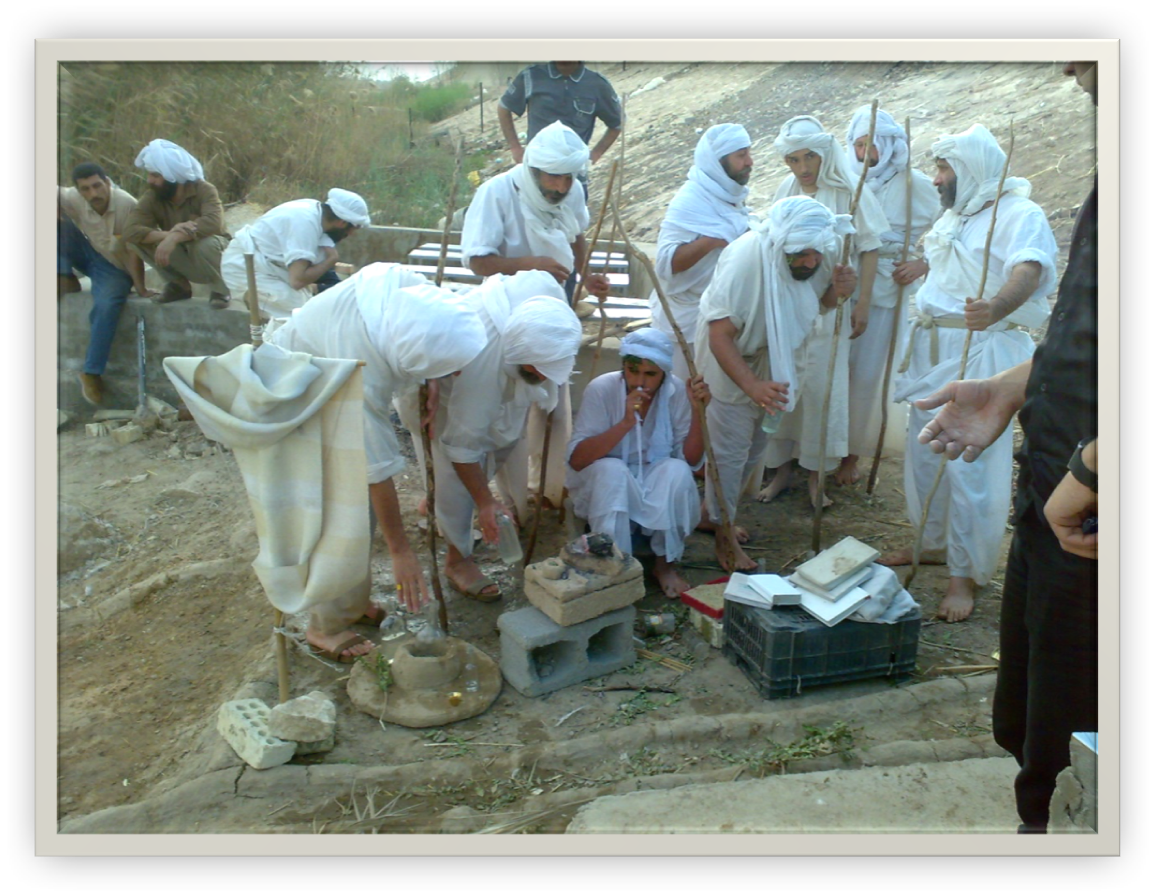Riha (Mandaeism) on:
[Wikipedia]
[Google]
[Amazon]

 In
In
Riha ḏ-basim
(Qulasta prayer 8) recited by Tarmida

 In
In Mandaeism
Mandaeism (Mandaic language, Classical Mandaic: ),https://qadaha.wordpress.com/wp-content/uploads/2021/03/nhura-dictionary-mandaic-english-mandaic.pdf sometimes also known as Nasoraeanism or Sabianism, is a Gnosticism, Gnostic, Monotheism, ...
, ''riha'' () is incense
Incense is an aromatic biotic material that releases fragrant smoke when burnt. The term is used for either the material or the aroma. Incense is used for aesthetic reasons, religious worship, aromatherapy, meditation, and ceremonial reasons. It ...
used for religious rituals. It is offered by Mandaean priests
A Mandaean priest or ''Tarmida'' () refers to an ordained religious leader in Mandaeism.
Overview
All priests must undergo lengthy ordination ceremonies, beginning with tarmida initiation. Mandaean religious leaders and copyists of religious text ...
on a ritual clay tray called ''kinta'' in order to establish ''laufa
In Mandaeism, laufa or laupa () is the concept of a spiritual connection forged between Tibil (Earth) and the World of Light. It has been variously translated as "communion," "spiritual union," "spiritual connection," or "vital connection."
In r ...
'' (communion) between humans in Tibil
In Mandaean cosmology, Tibil () or occasionally Arqa ḏ-Tibil (lit. "Tibil-Earth") is the Earth (World) or earthly middle realm. It is separated from the World of Light (''alma ḏ-nhūra'') above and the World of Darkness (Mandaeism), World of D ...
(Earth) and uthra
An uthra or ʿutra (, Neo-Mandaic ''oṯrɔ'', traditionally transliterated ''eutra''; plural: ʿuthrē, traditionally transliterated ''eutria'') is a "divine messenger of the light" in Mandaeism. Charles G. Häberl and James F. McGrath transl ...
s (celestial beings) in the World of Light
In Mandaeism, the World of Light or Lightworld () is the primeval, transcendental world from which Tibil and the World of Darkness emerged.
Description
*The Great Life ('' Hayyi Rabbi'' or Supreme God/ Monad) is the ruler of the World of Ligh ...
during rituals such as the masbuta
Maṣbuta (; pronounced ''maṣwottā'' in Neo-Mandaic) is the ritual of immersion in water in the Mandaean religion.
Overview
Mandaeans revere John the Baptist and practice frequent baptism (''masbuta'') as ritual purification, not of initia ...
(baptism) and masiqta
The masiqta () is a mass or ritual practiced in the Mandaean religion in order to help guide the soul ('' nišimta'') towards the World of Light in Mandaean cosmology. They are typically performed as funerary rites for Mandaeans who have just di ...
(death mass), as well as during priest initiation ceremonies. Various prayers in the ''Qulasta
The Qulasta, also spelled Qolastā in older sources (; ), is a compilation of Mandaean prayers. The Mandaic word ''qolastā'' means "collection".
The prayerbook is a collection of Mandaic prayers regarding baptisms ('' maṣbuta'') and other sa ...
'' are recited when incense is offered. Incense must be offered during specific stages of the typically lengthy and complex rituals.
In the ''Qulasta''
Several prayers in the ''Qulasta
The Qulasta, also spelled Qolastā in older sources (; ), is a compilation of Mandaean prayers. The Mandaic word ''qolastā'' means "collection".
The prayerbook is a collection of Mandaic prayers regarding baptisms ('' maṣbuta'') and other sa ...
'' are recited when offering incense, including prayers 8 ("") and 34.
Associated ritual objects
The ''brihi'' is a ritual clay fire saucer that is narrow end faces north. It is used for the riha andpihta
In Mandaeism, the pihta () is a type of sacramental bread used with rituals performed by Mandaean priests. It is a small, round, biscuit-sized flatbread that can either be salted or saltless, depending on whether the ritual use of the pihta is ...
.
The ''qauqa'' is a small terra-cotta
Terracotta, also known as terra cotta or terra-cotta (; ; ), is a clay-based non-vitreous ceramicOED, "Terracotta""Terracotta" MFA Boston, "Cameo" database fired at relatively low temperatures. It is therefore a term used for earthenware object ...
cube with a depression on top to hold the riha.
See also
*Incense offering
The incense offering ( ) in Judaism was related to perfumed offerings on the altar of incense in the time of the Tabernacle and the First and Second Temple period, and was an important component of priestly liturgy in the Temple in Jerusalem.
I ...
in Judaism
* Incense offering in rabbinic literature
The incense offering (), a blend of aromatic substances that exhale perfume during combustion, usually consisting of spices and gums burnt as an act of worship, occupied a prominent position in the sacrificial legislation of the ancient Hebrews.
...
* Kyphi
Kyphi, cyphi, or Egyptian cyphi is a compound incense that was used in ancient Egypt for religious and medical purposes.
Etymology
Kyphi () is romanized from Greek κυ̑φι for Ancient Egyptian language, Ancient Egyptian "kap-t", incense, fr ...
in Ancient Egypt
* Religious use of incense
Religion is a range of social-cultural systems, including designated behaviors and practices, morals, beliefs, worldviews, texts, sanctified places, prophecies, ethics, or organizations, that generally relate humanity to supernatural, transc ...
References
External links
Riha ḏ-basim
(Qulasta prayer 8) recited by Tarmida
Yuhana Nashmi
Yuhana Nashmi (; Mandaic language, Mandaic: ; also known as Sheikh Alaa Nashmi or Ala’a Nashmi; ) is an Iraqi-Australian visual artist and ceramicist.
Early life
Nashmi was born in Baghdad, Iraq. His ''malwasha'' (Mandaean name, baptismal name ...
Mandaic words and phrases
Incense
Mandaean religious objects
{{Mandaeism-stub